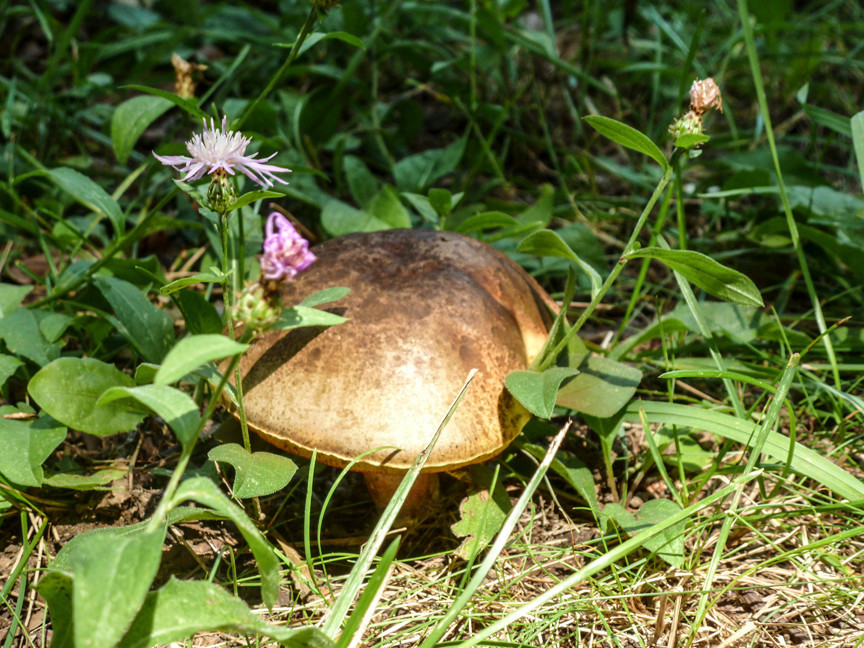Hunting for mushrooms while avoiding park rangers
On a sloped lawn in Van Cortlandt Park, off a paved path beneath century-old oak trees, an orange mushroom cap poked up amid wild grasses.
A Riverdale man, “Ben” (he asked that his real name be withheld due to the sensitive nature of the subject) stooped and gently plucked the fungus from the soil.
“These are called ‘lurid boletes,’” he said, nursing the specimen in his hand. “These babies are poisonous when raw, but if you boil them for awhile, and then sauté them, they become very edible and delicious – better than the pricey porcini mushrooms.”
The subject is sensitive because foraging in New York City parks is illegal. A few years back police tried to crack down on people hunting for edible wild plants, mushrooms and berries. Officers and park rangers chased off foragers, issued summonses and posted signs admonishing New Yorkers against gathering plants and fungi.
Using parks as snack bars could deprive the wooded areas’ inhabitants – such as chipmunks – of their meals, the city’s Parks and Recreation Department has been warning.
“For decades, it has been against NYC Parks rules to mutilate, kill, or remove any plants, flowers, shrubs or other vegetation without permission,” the department said in an emailed statement.
But that does not stop some people from trying.
The New York Mycological Society, for one, has been offering guided walks each summer for members and, occasionally, non-members who want to gather edible mushrooms and berries in the city’s parks.
“Ben” and a few of his friends, on the other hand, are independent freelance hunters. Self-proclaimed experts who have been gathering wild mushrooms for years or even decades, they roam Van Cortlandt Park alone or in pairs, scanning the ground for edible fungi – and constantly keeping a lookout for police officers or park employees.
They have avoided any legal troubles so far, “Ben” said, and harvests are often plentiful. Starting in mid-June, clusters of lurid boletes begin cropping up on park lawns, growing especially vigorously after a spell of warm and humid weather. On a good day, “Ben” and his friends might haul away several pounds’ worth of their delicious loot, concealed in plastic bags.
But this year’s early crops were scant: Mushrooms enjoy humidity, and June saw “abnormal dryness and draught,” in the words of NOAA’s environmental information centers, a service that monitors and records weather data. But August often brings a second wave of wild mushrooms, and after a recent series of rainstorms, lurid boletes began cropping up again in Van Cortlandt Park over the past few days.
Police who patrol Van Cortlandt Park to deter motorbike racers or violent assailants in the wake of recent slasher attacks do not seem to view cracking down on foragers as a top law-enforcement priority. But some officers question the wisdom of eating plants or mushrooms that grow in areas with heavy foot or car traffic.
“It happens all the time. To me, it’s amazing that people would eat … dandelions,” Deputy Inspector Terence O’Toole, the commanding officer of the 50th precinct, told The Press in a recent interview. “Dandelions are healthy, but I don’t know if I’d eat dandelions from the side of the Henry Hudson Parkway.”
Rangers also tend to get lenient, driven perhaps more by curiosity than by a wish to strictly enforce the rules.
“Technically, the Parks Department does not condone picking anything in city parks,” Mycological Society president Tom Bigelow said. But “we’ve never had problems. In fact, we’ve bumped into park rangers who have been interested in what we’re doing and have joined us on walks,” he said.
Officially, the city’s Parks Department “encourages New Yorkers to get their fill of leafy greens,” but urges anyone who is interested in harvesting plants to join the any of the department’s 600 “GreenThumb” community gardens around the city, it said in the emailed statement.
Mushroom hunters – both of the organized kind, such as those from the Mycological Society, and freelancers, such as “Ben” - are a motley group. They include vegans, believers in natural lifestyles, immigrants from Asia or Eastern Europe who grew up gathering and learning about wild mushrooms in their native lands – and people who simply are reluctant to pay for food when they believe there is free stuff available for grabs.
The supposedly free stuff can become costly, however. Fines for foraging can reach up to $250, according the Parks Department, although people who receive any summonses at all typically get away with fines of about $50, Capt. O’Toole said. An arguably greater danger lies in the fact that many wild mushrooms are deadly, and even potentially edible ones, such as lurid boletes, can be toxic if cooked the wrong way.
“When in doubt about any mushroom, just leave it alone,” Riverdale’s “Ben” said.
Mr. Bigelow of the Mycological Society added another note of caution to those who assume that everything that grown in parks is, almost by definition, free of contaminants.
“Anyone foraging for any kind of edibles in city parks should be aware that the city does regularly spray pesticides – Roundup – in all city parks,” Mr. Bigelow said.






